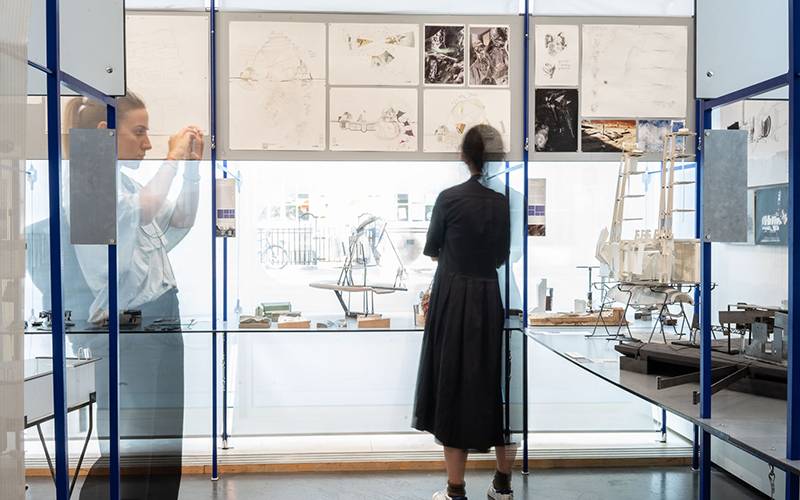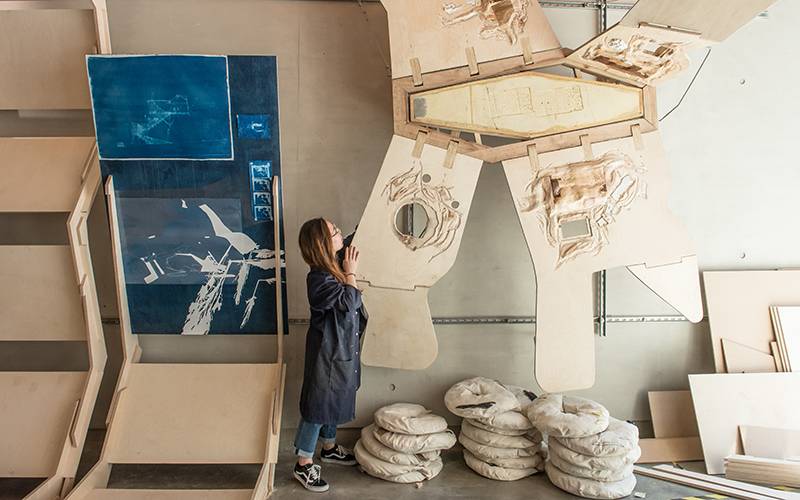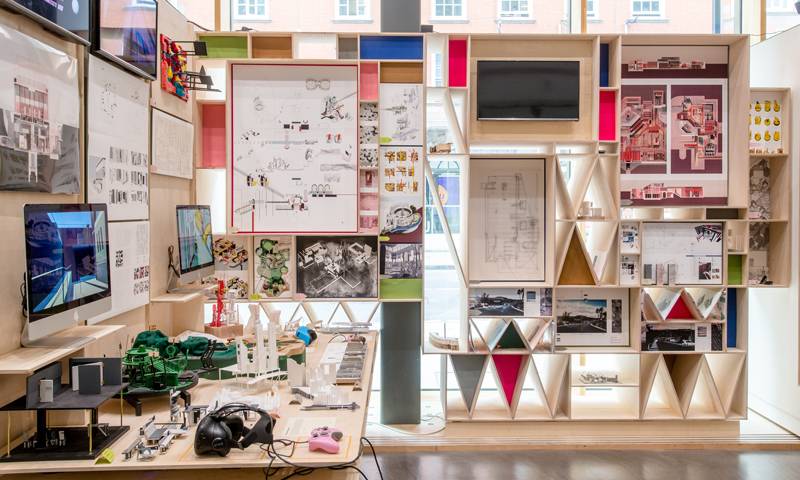A new and innovative five-year integrated degree in architecture, accredited by ARB for Part 1 & 2, with a final year on placement.
 About
About

Architecture MSci, a Master in Science in Architecture with Honours (Part 1 and Part 2), integrates the development of architectural design skills with an understanding of the complex social and technical environments in which buildings are produced. The programme guides students to become architects who are expert researchers and are both the initiators of building designs and effective members of the building team.
This design-based degree combines undergraduate and postgraduate architecture taught over five years, including the final year in placement in an architectural practice. In the first four years, students explore design and construction challenges facing the built environment, learning how to incorporate specialist disciplinary information with creative sophisticated designs, in response to an annual theme.
The structure of Architecture MSci encourages creative research from early on, whilst the final-year placement gives students the opportunity to potentially test their imaginative ideas in the real world, and potentially accelerate their earning power. Students on placement will only pay 20% of tuition fees. If the placement is unavailable, students have the option to join the final year of the school’s accredited Architecture MArch Part 2 programme.
Students choosing to exit the programme at the end of the third year can obtain a Bachelor of Science in Architecture and Practice with Honours (3 years, full-time) Part 1.
Highlights
- Work closely with world-class academic tutors and practitioners on design projects that explore the future of the built environment
- Develop creative architectural design skills alongside an understanding of social and technical environments
- Work in state-of-the-art bespoke facilities – both our studios and workshops are designed for creative flexibility and idea generation – and take part in the UK’s biggest student architecture Summer Show
- Enjoy being part of a world-leading community for studying, teaching and researching architecture and the built environment
- Build a professional network and learn about architectural practice first-hand during an architectural placement.
Modules
Year 1
- Design Project: Making Architecture (15 Credits)
Students work in groups to understand how micro architectures, from clothing and masks to gazebos and pavilions, modify the environment for their users and influence the way that the users present themselves to the outside world. Explorations should be imaginative, creative and ambitious. The module is supported by theory seminars that discuss the relationship between architecture, the body, and the mind.
- Design Project: Sample Building (45 Credits)
Working individually, students develop designs for a sample building in response to a brief which speaks to the programme’s overall annual theme. Students are taught the skills and methods to think to think creatively and innovatively in an architectural context, using different media and scales for their proposals.
- Structural Concepts and Tools (15 Credits)
Students learn the technical concepts used by structural engineers using qualitative analysis, based on physical and computing modelling skills. They learn about the comparative structural behaviour of a range of building materials and configurations. Students are taught the basics of sizing structural elements for their future design projects and are asked to make a structural appraisal of case studies and their sample building design project.
- Enviromental Concepts and Tools (15 Credits)
Students learn the technical concepts used by environmental engineers using qualitative analysis, based on physical and computing modelling skills. They learn about the comparative environmental behaviour of a range of building materials and configurations. Students are taught the basics of sizing environmental elements for their future design projects and are asked to make an environmental appraisal of case studies and their sample building design project.
- History and Theory (15 Credits)
This module introduces students to the history and theory of architecture with the new Sir Banister Fletcher’s Global History of Architecture (21st Edition, 2019) edited by The Bartlett’s Professor Murray Fraser. Students explore the content of the book through seminars, which are linked to physical journeys of exploration around London. Students then map and describe a personal journey of exploration.
- Skills Portfolio (15 credits)
This module uses case study-based workshops to teach students the latest digital and graphical software and physical and digital fabrication skills. Students prepare a portfolio submission based on the workshops and are encouraged to be imaginative and innovative in their representational approaches.
Year 2
- Design Project: Project Portfolio 1 (15 Credits)
In this module, students respond to the programme’s annual theme and a given suburban or rural location, working in small groups to identify a site within the location, create a brief and develop an initial design proposal. Observational studies can include approaches taken from ethnography, history, social science, environmental science and art practice and initial design proposals can be made at any scale with any appropriate media.
- Design Project: Project Portfolio 2 (45 Credits)
In this module, students continue to work in small groups to develop a clear integrated design proposal for their site that builds their observations in the initial design study. The design will demonstrate an appropriate understanding of structural and environmental design principles. Students attend a one-week design workshop, related to the annual programme theme, led by an academic or practitioner.
- Project Book (30 Credits)
Each student produces an appraisal of their Project Portfolio design proposals, describing the impact of the physical and cultural context of the site location and analysing the relevant design precedents.
Through seminars across all design modules, students develop an overall understanding of the theme and site location and how to develop structural, environmental and building envelope proposals in a sustainable manner.
- Professional Report (15 Credits)
Students learn how to analyse the professional context of a project throughout a series of seminars, exploring the role of the architect, procurement, construction and site safety, initial cost appraisal, and communication between the construction team. They are also introduced to simple digital project management and costing tools. Students write an individual critical appraisal of the Year 2 design proposals, informed by field trips to construction sites, subject to health and safety management.
- History and Theory (15 Credits)
This module introduces students to different ways of understanding the natural landscape, its relationship to rural society, and the role of architecture. Taught through a series of seminars, students work in groups to discuss and present on topics including rural architecture, art, landscape and situated practice, and the economics and politics of landscape settlement, culminating in a written paper investigating a chosen seminar topic.
Year 3
- Design Project: Research by Design 1 (15 Credits)
Introduced with presentations from academics and practitioners about practice-based research methods, students identify an individual research question, based on the programme annual theme, which can be researched by design. Working closely with tutors, students agree a mode of working and undertake initial investigations
- Design Project: Research by Design 2 (60 Credits)
Students develop the research question identified in Year 3 Research by Design 1, working towards a final portfolio that alongside extensive design work will usually include a written component, depending on the research question. Design can be undertaken in any appropriate medium including time-based media, for example, 1:1 prototypes, installations, drawings, models, video, or games software.
- Theory Dissertation (30 Credits)
Students write a 5000 word dissertation based on the programme’s annual theme. Students are supported by a dedicated personal dissertation tutor and the module coordinator.
- Personal Skills Portfolio (15 Credits)
In this module students identify a skill relevant to their portfolio of work to develop and have the opportunity to work individually with a skills tutor from across. Personal skills choices could include fine art practice, advanced computation, advanced fabrication, performance practice, or economic analysis.
Year 4
- Design Project: Project Portfolio 1 (15 Credits)
In this module, students base their work on the programme’s annual theme and a given urban location. Students work to identify a site within the location, create a brief and develop an initial design proposal. Observational studies can include approaches taken from ethnography, history, social science, environmental science and art practice. Initial design proposals can be made at any scale.
- Design Project: Project Portfolio 2 (60 Credits)
Students work individually to develop an integrated design proposal for their site. Students experiment with different approaches to design and representation and develop an ambitious and critical approach towards the conceptual, functional and programmatic dimensions of the project. Each proposal should respond to the site, content and brief, and critically examine the urban and social context. Proposals should also incorporate an appropriate understanding of structural and environmental design principles, including fire safety and environmental control requirements.
- Project Book (30 Credits)
Each student develops an appraisal of their Project Portfolio design proposals, appraising the impact of the physical and cultural context of the site location and of relevant design precedents. Students develop and demonstrate an understanding of sustainable structural and environmental design principles, fire safety, and inclusivity. Students are also asked to consider how their proposed buildings are designed, constructed and delivered, reflecting on the relationship between building design and technology, the environment, the construction industry and the profession.
This module and the Design Project modules will include lectures and seminars where students learn how to understand the overall theme and site location (with particular reference to urban issues), how to sustainably develop structural, environmental and building envelope proposals, and relevant professional practice issues.
- History and Theory (15 Credits)
This module introduces students to different ways of understanding cities and urban society, and the role of architecture in this context. Students work in seminar groups to explore and present topics, including modes of subjectively understanding the city, and how the design and development of cities influence the contemporary built environment, culminating in a written paper investigating a chosen seminar topic.
Year 5
- Research in Practice/Placement in Practice (120 Credits)
For the final year of studies students will pay only 20% tuition fees.
Students work in placement in Year 5 and link back to UCL where they investigate a research topic based their design experience, as well as their own research interests developed in the first four years of their studies. Every student will have a UCL academic mentor and a practice-based mentor for this placement year. Students will work with their academic and practice mentors to identify a research topic and to develop a research proposal.
Students will also spend up to 75% of their time on design work in the architectural practice. This will be recorded in a Practice Design Portfolio.
If a placement is not available, students can conclude their studies by joining the final year Architecture MArch (ARB/RIBA Part 2) programme. Students concluding Architecture MSci on campus will pay 100% of the annual tuition fee.
Key information
Modes/duration
This programme is taught full-time over a period of five academic years.
Entry requirements
Read the full entry requirements for this programme on the UCL Undergraduate Prospectus
Application deadline
Applications are now close for 2024 entry.
Fees and funding
- Tuition fee information can be found on the UCL Undergraduate Prospectus
- For a comprehensive list of the funding opportunities available at UCL, including funding relevant to your nationality, please visit the Scholarships and Funding section of the UCL website.
Accreditation
Architecture MSci is accredited by the Architects Registration Board (ARB). Students who successfully complete the programme are exempt from Part 1 and Part 2 of the ARB examinations.
Careers
Architecture MSci is designed to support students to becoming highly-skilled architects. The school’s graduates have an excellent record of employment and destinations vary from internationally renowned offices to small-scale specialist practices.
The structure of Architecture MSci encourages students to develop collaborative links with practice, and provides an opportunity to develop real-world experience, build their professional network and knowledge of the industry, and potentially accelerate their earning power.
Contacts
Programme Director: Murray Fraser
Undergraduate Admissions enqueries: Complete the contact form
Departmental Tutor: Tom Keeley (Year 1,2,3,4)
Programme Administrator: Alice Whewell
 Close
Close



